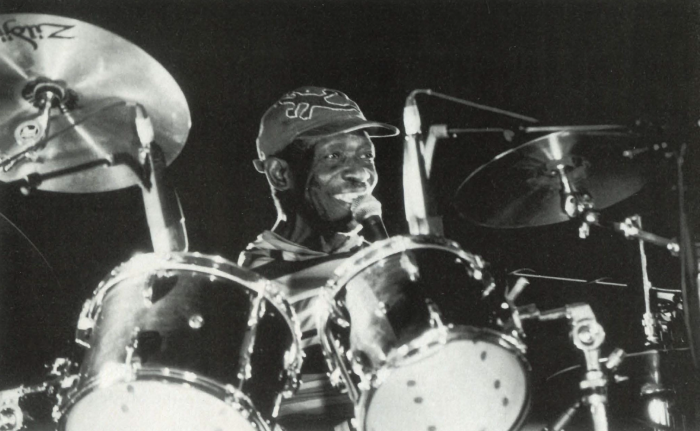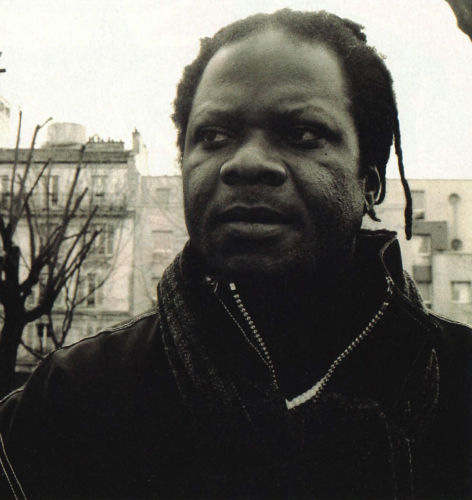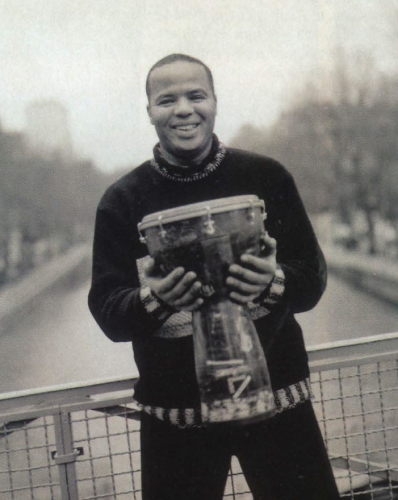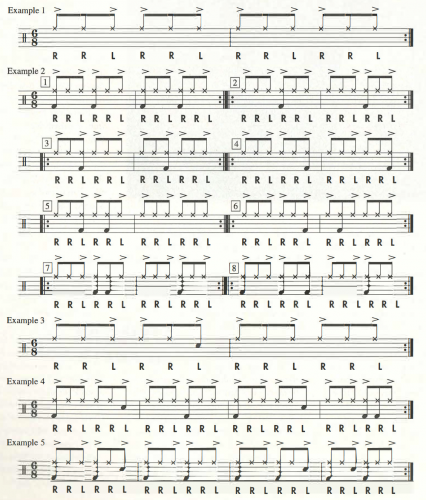BY DAN THRESS | FROM THE MAY-JUNE 2001 ISSUE OF DRUM!
Drummers around the world acknowledge the African origin of their instrument. Some of the greatest like Elvin Jones, Ed Blackwell, Ginger Baker, Jack DeJohnette, Stewart Copeland, Micky Hart, and others have spent time in Africa for inspiration or validation. But what about the drummers from the motherland? You are about to meet three incredible African drummers who live in Paris. Each has made enormous contributions to the vocabulary, yet is practically unknown on these shores. If they were African-American rather than Afro-French, all three would make everyone’s top 25 list of the greatest drummers of all time. Tony Allen, Brice Wassy, and Mokhtar Samba possess so much drumming skill and experience that their rhythms, tempos, solos, compositions, and collective spirit can feed generations of new drummers searching for the perfect groove … if you can find their records!

Tony Allen. Photo by Olivier Gelebale, courtesy of Comet Records
Tony Allen: Afrobeat Pioneer
When I first moved to Paris, drummers-in-the-know told me about a drummer named Tony Allen. They usually said, “He has his own style and he used to play with Fela [Kuti]!” Frankly, I had never heard of him. It wasn’t until I picked up a new CD from Tony Allen titled Black Voices that everything became clear. The collection is a dark experimental journey based around Allen’s afrobeat grooves mixed with vocals, guitar lines, off-center brass, and DJ cuts. It’s wicked.
After trying to decipher the rhythms on the CD, I was fortunate to catch Allen and his group Afrobeat 2000 at an outdoor festival in the North of Paris. Flanked by an excellent African bassist, two electric guitarists, a Fender Rhodes player and a small horn section, Allen laid out one infectious groove after the other while singing lead. The show lasted almost two and a half hours before the promoter shut them down, much to Allen’s dismay.
This was a short concert compared to the marathon sessions that he performed with Fela Kuti and Africa 70. Indeed, even in the studio Fela’s songs could go on for 15 minutes or longer. One of Allen’s trademarks is his ability to keep the grooves interesting during these long jams. “I don’t believe in the drummer who sits down and puts his whole body into the beat,” he says. “It’s not my body that plays the drums, it’s my arms and my legs. I use my wrists. The rest of me needs to be quite still for concentration.” His size and posture is remarkably similar to the late Tony Williams, and when I mention this it brings a grin. “I never saw him live but I heard him on many records, and he was a cookin’ drummer.”
Afrobeat is a bold name credited to the lace Nigerian bandleader Fela Kuti. It is also Tony Allen’s groove, and he’s been keeping the fires burning by mixing afrobeat with dub and DJs while touring Europe and America with his band of French and African musicians. Afrobeat is not only a style, but also a mission for Tony Allen. “We have funk drumming, rock drumming, reggae drumming, and we have afrobeat drumming. Not everybody knows about this style and I want to show people what it is. I don’t want people to play false afrobeat music. Sometimes I hear people trying to play in an afrobeat way but the drummer is just playing funk or whatever. That is not afrobeat music. You don’t just jump up and play whatever you want to play.
“The music has certain ingredients,” Allen explains. “First the legs got to get walking. My hi-hat does not stay closed—to me that is not good drumming. The hi-hat is one of the keys to opening the rhythm. If the drummer can’t use his hi-hat then he will never be able to play for long periods of time. It would be very boring.”
Afrobeat is not a specific groove any more than hip-hop is a groove, but there are certain guidelines to explore. First, although afrobeat is in 4/4, it disregards such elements of funk or soul as backbeats and “playing on the 1.” Most grooves are played on the hi-hat, which is in constant motion. As in jazz, the pattern is not static, and when the music needs a lift, Allen injects sixteenth-notes and open figures to let the groove breathe. The bass drum commonly plays a repeating pattern, usually two sixteenths in succession that play off the snare, drum pattern. On the snare drum, he chooses a pattern that answers the bass drum, and constantly riffs with buzzes and accents to drive the band.
Nobody doubles one another in the group. The bass player doesn’t reinforce the bass drum and everybody must find an interlocking part with one another. Allen’s parts are complete in themselves, with an internal logic that becomes clearer with practice. He offers this advice, “Don’t think you have four things going at once – think one rhythm in a straight line. It’s one person playing like four.” While Afrobeat sounds demanding, keep in mind that the purpose is to move an audience. “Afrobeat is serious dance music,” Allen says. “I play like a machine or a loop. I make it steady for the audience to let them find something in the drumming.” Allen adds, “I don’t have limits of beat creations. What the music brings, that’s what I give back. The music is coming from the drums.”
Allen states that nobody in Nigeria played this style on drum set before he did in the ’70s. So what influenced him? “When I was young I listened to native music,” he explains. “I’m from Yoruba land, like Fela, where you will find Ebo rhythms. My mother’s side is from Ghana, so I listened to hand drummers from my area and to drummers from Ghana. In Lagos, the capitol of Nigeria, I paid a drummer to show me how the trap set worked. Three months later, after checking out all the best drummers in town, I was working. Each club or hotel needed a band, and the owner of each club would own all the instruments so it was really like you worked for him.
“The music would be highlife and ‘copyrights,’ which are cover versions of European and Caribbean music including tangos, calypso, and so on. I played the sticks [clave] for nine months. After nine months I was playing like I had been playing for nine years. For the next three years I played the highlife rhythms that I learned from other drummers, then I started adding the hi-hat to the highlife grooves. Highlife is originally from Ghana but you can hear it in Nigeria, Senegal, and the Ivory Coast. Every bandleader had his own highlife songs. Highlife was the rock and roll of West Africa.”
Allen continued his education in an informal way. “In my generation we listened to live drummers and the radio. When any band came to Lagos, I was there. I used to hear Gene Krupa on the radio! He was a good drummer and I tried to copy some of his solos, but when I heard Art Blakey, Max Roach, Elvin Jones, and Philly Joe Jones, I thought, ‘Now I’m listening to drumming with colors.’ Their styles related more to what was happening in my country.”
https://youtu.be/T3kESQvHYpE
To immerse yourself in the grooves of Tony Allen, check out a release from guitarist Ernest Ranglin called Modern Answers to Old Problems (released in the US on Telarc). You can also look for two releases from Tony Allen and Africa 70 titled Jealousy and Progress, released on one CD, and No Accommodation For Lagos and No Discrimination, also released on one CD.

Brice Wassy. Photo by Dan Thress
Brice Wassy: Jazzy Fusionist
Not only a remarkable drummer, Cameroon-born Brice Wassy has also become a skilled composer who often sings his own material. One of those strong but gentle types, Wassy explains his mission: “I play music, not drums. I’m still a drummer, but I like to bring my own tunes. Just because you are a drummer, it doesn’t mean you can’t hear melodies and harmonies.”
Being raised in Youondi, Cameroon shaped Wassy’s approach to art as well as life. Often frustrated by the business side of the music, Wassy has nonetheless managed to make enormous contributions to African music by getting the music out of Africa. He explains how he came to find his voice while living in Africa: “Cameroon was colonized by France, and what we heard on the radio was a mix of things from America and France. I used to play pots and pans and sing along with Ray Charles, ‘Baby, what I say’ and James Brown at the Apollo, ‘Hey, hey, I feel all right,’ but we didn’t understand English at the time,” he laughs.
When Wassy was a teenager he moved to Paris and things began to change. “When I came to France I became influenced by Tony Williams, Billy Cobham, and Ndugu Chander, because that was the style that guys like Mokhtar Samba and Manu Katche were playing in Paris at the rime. Thar’s the music of our generation. I felt Ndugu was very African in his approach.”
In the lace ’70s, Paris was just starting to take notice of the talented Africans living amongst them, and soon the sound of Paris was changing. Wassy had come at the right time. “I played a lot of African sessions with people such as saxophonist Manu Dibango. One tune called ‘Manganbolo’ stirred up a lot of interest in my drumming. That groove was in 12/8. Also Manu’s album Waka Juju, which was influenced by Fela, helped my reputation. Manu Dibango represented the African musician in France. He was like our Miles Davis. It was a challenge to work with him and he fed off of our energy.”
Jazz is considered popular music in France, and Wassy also contributed to tours with Don Cherry, Collin Walcott, and Jim Pepper. “We just played. It was experimental. I was young at this time and sometimes the ideas flowed naturally and sometimes not.” Wassy sees no difference from what Americans call jazz and African music. “If jazz is improvisation then traditional African music is jazz. Santana is not playing rock, just the sound of rock, just like the guitar players who use distortion in Zaire. Everything can mix with African music. The sounds are going to change.” He adds, ”Another misconception is that funk is an African style, but it’s an American style.”
Word was getting around Paris about Wassy’s abilities and soon he found himself musical director for powerful Malian singer, Salief Keica. Wassy explains, “Salief ‘s manager called me and said that Salief was stopping his group Les Ambassadeurs, and they were putting together a project that would become his first solo record, called Soro. He asked me if I would play drums on the album and put the band together. So I put the band together. We rehearsed every day for a month, then did the album.”
Soro went on to become the biggest landmark in the Afro-French scene, putting Paris on the map as multicultural ground zero. Wassy was only 23 at the time and was soon touring Japan and the United States. He stayed with Keita for six years, and recorded another release called Ko-Yan. After working with Salief Kieta, Wassy received a call from electric violinist Jean-Luc Ponty’s producer, Wally Badarou (Grace Jones, Level 42), who told him that Ponty wanted to do an African album. Wassy remembers, “He came to my house and I played him some of my compositions like ‘Tchokola’ on my computer and told him, ‘This is from Central Africa, this is from West Africa. Where do you want to go?’ I called all the musicians and two weeks later we were in the studio recording. I like that record (titled Tchokola after Wassy’s composition) but I think it was done too fast. Later on the tour Jean-Luc was playing more inside the music. We toured in the States for two months, it was nice.”
In the early ’90s, Wassy began recording under his own name. His three eclectic releases are available from the British label Melc2000, which has also recorded several records with Brazilian percussionist Airto Moreira. Wassy talks about the progression: “Everything I’m doing now is coming from N’ga Funk, my first record. I put a lot of different elements on that record. On my second record, Shrine Dance, I tried to make it more accessible and that got labeled as too much jazz,” he laughs.
On Shrine Dance, both [Cuban master percussionist] Changuito and Airto—who were also recording at Peter Gabriel’s Real World studios—played percussion. In this mix of Africa meets Brazil meets Cuba, there were some humorous moments. “Changuito told me my music was difficult,” Wassy laughs. “I hope to go to Cuba and Brazil with my compositions and meet them properly and have the musicians play different rhythms, but with their spirit. I love the way Airto plays, it’s like he is cooking in the kitchen and adding ingredients as needed. I didn’t give him any direction in the studio, you don’t need too.”
Wassy’s third and most recent recording, Balengu Village, is a journey back to his roots in Cameroon. Wassy explains, “I went to my village with a digital recorder. The drums they play there are sometimes called tom [pronounced toom]. You play them with your palm, and some people play with one or as many as four drums. They can sound like congas depending on how you tune them. The larger drums play the melodies and the smaller drums keep time.” Balengu Village is an extremely rich look at the African landscape, featuring beautiful vocals with deep drum accompaniment.
Wassy has an experimental spirit when it comes to music. “Hopefully, you can take inspiration from me and develop your own style,” is his parting statement. I asked him where he was headed: “There is a 4/4 rhythm in Cameroon called joka that is very interesting. The bass drum is not constant and it’s very cool and uptempo. I’m going to work on that

Mokhtar Samba. Photo by Robert Mann
Mokhtar Samba: Jack of all Trades
Mokhtar Samba emphatically says that he is a drummer who is African by birch, because his mother is from Morocco and his father from Senegal. He isn’t in denial of his heritage, it’s just that Samba has a very worldly view and is quick to sidestep pigeonholes. This is apparent as I check out his CD and video collection, which contains everything from Miles Davis to Mike Tyson’s greatest knockouts. “I’m just trying to be a drummer putting different influences on the drums every single day,” he explains.
Samba’s worldly approach has powered the music of Youssou N’Dour, Salief Keita, Carlinhos Brown, Richard Bona, Ultramarine, Joe Zawinul, Jean-Luc Ponty, and other top jazz and fusion groups in Europe. Along with Algerian born drummer Karim Ziad, Samba has also made his mark in adapting North African percussion rhythms on the drum set. His multi-African heritage mixed with his insatiable quest for drumming knowledge, has made him a bandleader’s dream. In short, Samba can play anything he wants to play.
”African music is not a single type of music,” he says. “All of us in Europe have to play all different types of African music to be able to work. Each of these countries has a similar feeling and energy.” This is indeed true as witnessed on Salief Keita’s release Folon… The Past, where Samba deftly handles a multitude of African styles with precision and depth. These challenges suit him just fine. “I speak five languages: French, English, Spanish, Arabic, and a little Senegalese. It’s an advantage and disadvantage to me because I can see things from a lot of different perspectives. I like my music the same way—mixed.”
Another characteristic that sets Samba apart from all the rest is his quest to blend African rhythmic systems with Western drumming techniques. In his apartment you’ll find practice pads, a drum machine, and American drumming books on independence and technique. He’ll set up African ostinatos and run these exercises for hours. But this technical journey then cakes an extra step that the rest of us miss. These chops are put to use while adapting solos from master hand drumming recordings from Morocco, Guinea, and Senegal.
“You won’t understand any of the African beats unless you understand the percussion,” he explains. “Fifteen years ago there weren’t any drum set players playing in bands in Africa, only hand drumming. We’re just starting to develop this art form. The more that we play these ideas the more they will become accepted. Just like Cuban music, for instance, playing with the clave, it’s not easy but it can be learned. We’re taking hand percussion rhythms, putting it on the drums, and creating a pocket.”
Samba further illustrates the similarities and the differences of African and Cuban music.
“To me the real African hand drumming is coming from the djembe and the sabar drums. The rest is just an adaptation of these patterns. In Cuban timba music we hear guys adding the clave with the foot and ocher independent parts, but in Africa it’s more about how you can make the same groove more powerful by repeating phrases, which leads to a trance-like state. To me, the key to African music is its energy.
Another rich source of African drumming is found in the traditions of the sabar orchestras in Senegal. Samba has had the honor of touring with Senegal’s brightest star, Youssou N’Dour. ”I’ve been to many places, but Senegal is special,” he says. “Youssou N’Dour lives in Senegal and when he plays in Africa he plays his original style. When he comes to Europe he adapts his style because European audiences—who are not used to listening to the serious rhythm of the sabar orchestras—become totally lost. The percussion section is playing a thousand notes and the time is so different. The drum set part is a big challenge. You have to play the groove, but most important is the time. Most of the parts that I play with him are simple, but when you listen to the position of the bass, guitar, and percussion everything locks into place. I listen to his percussionists, Assane Thiam and Babacar Faye, because there is a logic to everything they play. Youssou’s bass player Habib Faye plays the sabar in clave, including his fills. In fact, Habib is playing percussion parts on the bass. Every phrase has a relation to the drums.”
Every part played on drum set comes from the rhythm of the percussion as well. Samba explains: “In African music you can’t play three bars of time then a big fill in the fourth bar. In African music the rhythm and the fills are one. Your fills are just a part of the rhythm, and are not for transitions necessarily. This is a very important concept. The fills have to be inside the rhythm, just like in Cuba.”
When I meet such an accomplished musician as Samba, I must admit my American background makes me wonder why he doesn’t move to the States, where he might find more opportunities. Samba explains, “The best thing about living in France is all the people you can meet from different countries. The most frustrating thing about living in France is finding people who can promote and support your music. We have to work for singers or we are in big trouble. When I was doing festivals with my band Ultramarine, drummers such as Vinnie Colaiuta and Will Kennedy used to ask me, ‘Where can we get your records in the United States?’ We have the music here, that is for sure. We just need the international structure to get it out.”
Guide to Gnawa
By Mokhtar Samba
Gnawa music is from the south of Morocco, Algeria, and Tunisia, but mostly from Morocco. I grew up hearing this rhythm in Morocco. Each Friday in Morocco the Gnawa musicians play in the street. Parents tell their children that unless they behave the karkabous (metal castanets) player will play the karkabous on their ears! So, as a child I remember being totally transfixed by watching these musicians and listening to these grooves. It was as if they were talking to you. In a Gnawa band there is percussion, but no drum set, so what we play is an adaptation. The instruments you are imitating are the karkabous. Place your pattern inside the rhythm of these percussion instruments. It will take time. Just like learning traditional jazz or Brazilian music, you have to spend years developing the appropriate feel or swing of the style. It takes a great deal of time to become comfortable in the special language of the style.
In Ex. 1 you’ll find the basic hi-hat pattern, which imitates the sound of the karkabous. Then we add eight bass drum patterns in Ex. 2 and snare drum in Ex. 3. We put together the bass drum and snare in Ex. 4, and in Ex. 5 gives a variation you can use for commercial dance music or to lift the chorus of a song.

